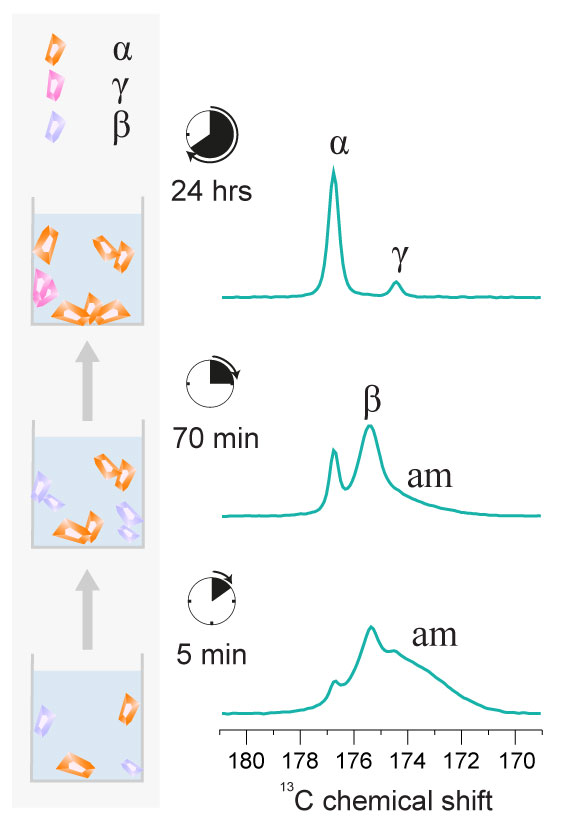NMR for crystallization

NMR to study crystallization from solution
Crystallization plays an important role in many fields of biology, chemistry, and materials science, but the underlying mechanisms that govern crystallization are still poorly understood due to experimental limitations in analyzing these complex and constantly evolving systems. To gain a fundamental understanding of crystallization processes, it is essential to access the sequence of solid phases produced as a function of time, with atomic-level resolution. The rationalization of crystallization processes is particularly relevant for polymorphic materials. Indeed, polymorphism can have enormous economic and practical consequences for industrial applications in pharmaceuticals and energy because different polymorphs have different physicochemical properties. While, on the one hand, this offers great opportunities to modulate the performance of the material according to the desired application, on the other hand, unexpected polymorphic transitions induced by manufacturing or storage can compromise the end use of the solid product. Interestingly, these transformations often involve the formation of metastable forms, which are the subject of increasing attention because they may offer new crystal forms with improved properties.
Today, the detection and precise structural analysis of these – usually transient – forms remain difficult, mainly due to the current limitations of the temporal and spatial resolution of the analysis, which prevents rationalization (and therefore control) of crystallization processes. Several in situ techniques, including diffusion, spectroscopy and microscopy, have been applied to a large number of materials to try to observe the structural changes that take place in the crystallization medium, but limitations persist, both in terms of structural and time-resolution of the analysis. In this complex context, the nucleation of a solid remains one of the most interesting and difficult aspects to understand. Indeed, the supercritical species formed at the early stages of solid growth are generally nanometric, their concentration is very low and they move very fast. Therefore, it is very difficult to identify them and then follow their evolution in the crystallization medium.
In order to better understand polymorphism and be able to control the formation of a specific polymorph, we focus on exploring new strategies to study the crystallization process via hyperpolarized solid-state NMR, so as to gain new insights into the fundamental mechanisms leading to the formation of a polymorph, notably by accessing the early stages of crystallization.
Associated members
Collaborators
Dr. Thierry AzaïsCrystallization of calcium phosphates
Associated publications
Monitoring crystallization processes in confined porous materials by dynamic nuclear polarization solid-state nuclear magnetic resonance
M. Juramy, R. Chèvre, P. Cerreia-Vioglio, F. Ziarelli, E. Besson, S. Gastaldi, S. Viel, P. Thureau, K. D. M. Harris, G. Mollica*
Journal of the American Chemical Society, 143 6095-6103 (2021)
A strategy for probing the evolution of crystallization processes by low-temperature solid-state NMR and dynamic nuclear polarization
P. Cerreia-Vioglio, P. Thureau, M. Juramy, F. Ziarelli, S. Viel, P. A. Williams, C. E. Hughes, K. D. M. Harris, G. Mollica*
The Journal of Physical Chemistry Letters, 10 1505-1510 (2019)
Insights into the crystallization and structural evolution of glycine dihydrate by in situ solid-state NMR spectroscopy
P. Cerreia Vioglio, G. Mollica, M. Juramy, C. E. Hughes, P. A. Williams, F. Ziarelli, S. Viel, P. Thureau, K. D. M. Harris
Angewandte Chemie International Edition, 57 6619-6623 (2018)





